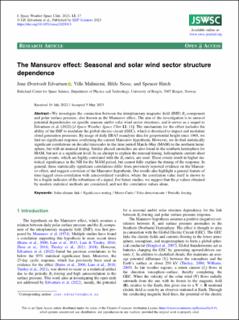| dc.contributor.author | Edvartsen, Jone Øvretvedt | |
| dc.contributor.author | Maliniemi, Ville Aleksi | |
| dc.contributor.author | Nesse, Hilde | |
| dc.contributor.author | Hatch, Spencer Mark | |
| dc.date.accessioned | 2023-09-14T11:06:09Z | |
| dc.date.available | 2023-09-14T11:06:09Z | |
| dc.date.created | 2023-08-18T09:13:05Z | |
| dc.date.issued | 2023 | |
| dc.identifier.issn | 2115-7251 | |
| dc.identifier.uri | https://hdl.handle.net/11250/3089423 | |
| dc.description.abstract | We investigate the connection between the interplanetary magnetic field (IMF) By-component and polar surface pressure, also known as the Mansurov effect. The aim of the investigation is to unravel potential dependencies on specific seasons and/or solar wind sector structures, and it serves as a sequel to Edvartsen et al. (2022) [J Space Weather Space Clim 12: 11]. The mechanism for the effect includes the ability of the IMF to modulate the global electric circuit (GEC), which is theorized to impact and modulate cloud generation processes. By usage of daily ERA5 reanalysis data for geopotential height since 1968, we find no significant response confirming the current Mansurov hypothesis. However, we do find statistically significant correlations on decadal timescales in the time period March–May (MAM) in the northern hemisphere, but with an unusual timing. Similar phased anomalies are also found in the southern hemisphere for MAM, but not at a significant level. In an attempt to explain the unusual timing, heliospheric current sheet crossing events, which are highly correlated with the By-index, are used. These events result in higher statistical significance in the NH for the MAM period, but cannot fully explain the timing of the response. In general, these statistically significant correlations differ from previously reported evidence on the Mansurov effect, and suggest a revision of the Mansurov hypothesis. Our results also highlight a general feature of time-lagged cross-correlation with autocorrelated variables, where the correlation value itself is shown to be a fragile indicator of the robustness of a signal. For future studies, we suggest that the p-values obtained by modern statistical methods are considered, and not the correlation values alone. | en_US |
| dc.language.iso | eng | en_US |
| dc.publisher | EDP Sciences | en_US |
| dc.rights | Navngivelse 4.0 Internasjonal | * |
| dc.rights.uri | http://creativecommons.org/licenses/by/4.0/deed.no | * |
| dc.title | The Mansurov effect: Seasonal and solar wind sector structure dependence | en_US |
| dc.type | Journal article | en_US |
| dc.type | Peer reviewed | en_US |
| dc.description.version | publishedVersion | en_US |
| dc.rights.holder | Copyright 2023 The Author(s) | en_US |
| dc.source.articlenumber | 17 | en_US |
| cristin.ispublished | true | |
| cristin.fulltext | original | |
| cristin.qualitycode | 1 | |
| dc.identifier.doi | 10.1051/swsc/2023013 | |
| dc.identifier.cristin | 2167841 | |
| dc.source.journal | Journal of Space Weather and Space Climate | en_US |
| dc.identifier.citation | Journal of Space Weather and Space Climate. 2023, 13, 17. | en_US |
| dc.source.volume | 13 | en_US |

